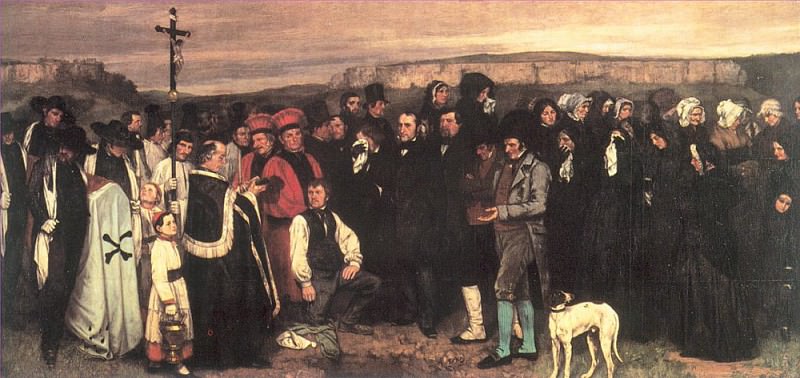A Burial at Ornans Gustave Courbet (1819-1877)
Gustave Courbet – A Burial at Ornans
Edit attribution
Download full size: 1000×472 px (0,1 Mb)
Painter: Gustave Courbet
Gustave Courbet’s work is dedicated to his grandfather, after whose funeral, the artist had the idea of capturing the event on canvas. Many in attendance were eager to be in the painting. And so it happened. As the artist said afterwards, it was very difficult to accommodate so many people in his small studio. He was posed by the vicar who conducted the ceremony, the mayor who attended the funeral, and the ordinary people who sang for the deceased.
Description of Gustave Courbet’s painting "Funeral in Ornan"
Gustave Courbet’s work is dedicated to his grandfather, after whose funeral, the artist had the idea of capturing the event on canvas. Many in attendance were eager to be in the painting. And so it happened. As the artist said afterwards, it was very difficult to accommodate so many people in his small studio. He was posed by the vicar who conducted the ceremony, the mayor who attended the funeral, and the ordinary people who sang for the deceased. Many whom Courbet forgot to invite resented him, demanding their participation.
The grim atmosphere of the funeral is emphasized by both the grimaces on the faces of those present and the background of the sky. Many could not stand hiding their faces under scarves, while others conducted the ceremony with serene faces. Given that most of Courbet’s work has darkened over time, one can assume that the action unfolds in the midst of white day. This conjecture also seems fair, given the white clouds at the right edge of the painting.
On the left we can see people in hats carrying a coffin. Their faces are downcast, emphasizing the significance of the deceased in life. Sadness is also evident on the guests of honor. For example, the mayor in his black triangle. He is near the funeral pit and extends his hand. Next to him is, by all appearances, a close relative of Courbet. Sitting down on one knee, he waits for the casket to be lowered.
Particularly striking is the cross with the crucified man. At first this causes bewilderment, because where does such a phenomenon come from in the middle of French soil. And the time, judging by the clothes of those present, is close to the 18th century. However, if you look closer, it becomes clear that this is a cross with a crucifix held in the hand of a minister of the church. Then everything falls into place.
Кому понравилось
Пожалуйста, подождите
На эту операцию может потребоваться несколько секунд.
Информация появится в новом окне,
если открытие новых окон не запрещено в настройках вашего браузера.
You need to login
Для работы с коллекциями – пожалуйста, войдите в аккаунт (open in new window).




















You cannot comment Why?